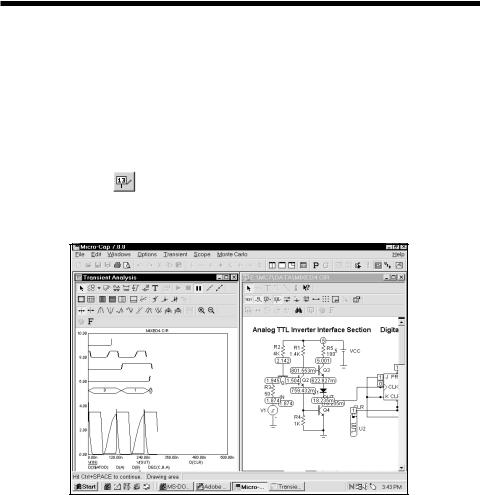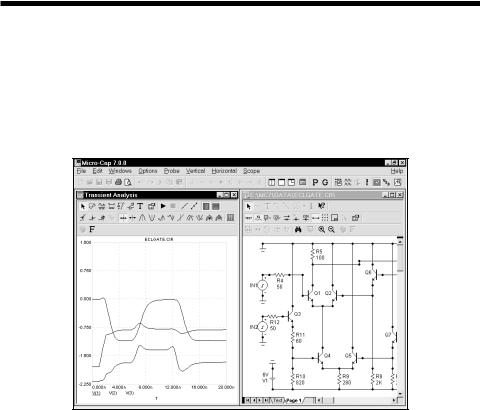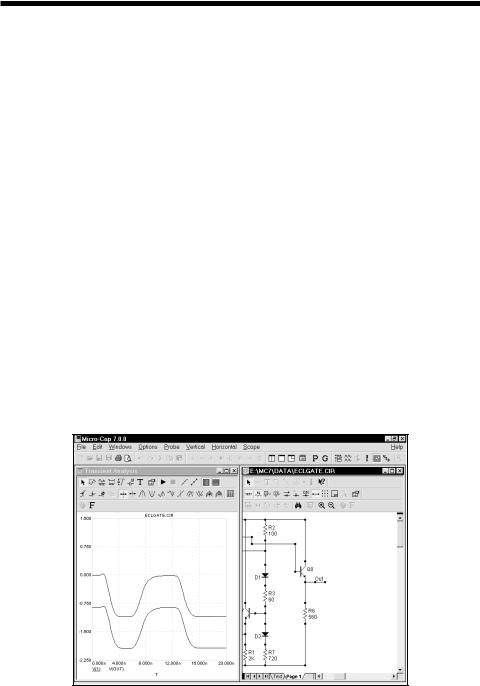
Micro-Cap v7.1.6 / Ug
.pdf
Performance functions also work on digital curves. Select D(11) from the Expression list and Rise_Time from the Function list. Set N=2 and click the Go To button. The result looks like Figure 7-24.
Figure 7-24 Measuring digital rise times
Select the Fall_time function. The result for N=2 looks like Figure 7-25.
Figure 7-25 Measuring digital fall times
155

Animatingananalysis
It is often useful to step through an analysis one time point at a time. Animation mode lets you do this and displays the node voltages and digital states on the schematic at each time point. To see how the mode works, load the file MIXED4. Select Transient from the Analysis menu. Press ALT + F4 to remove the
Analysis Limits dialog box. Click on the Tile Vertical  button. Click on the Animate
button. Click on the Animate  button, select the Wait for Key Press option, and hit OK. Click on
button, select the Wait for Key Press option, and hit OK. Click on
the Node Voltages . Click on the Run  button. Press and hold the CTRL and SPACEBARS keys down to observe each new data point being computed and printed on the schematic.
button. Press and hold the CTRL and SPACEBARS keys down to observe each new data point being computed and printed on the schematic.
Figure 7-26 Animating an analysis
The figure above shows what the screen should look like midway through the run. In this mode, MC7 computes a single data point, optionally prints the voltages/ states, currents, power, and conditions on the schematic, and then awaits the CTRL + SPACEBAR key or time delay. It then repeats the cycle of compute, print, and pause until the run is complete. When Animate mode is canceled by clicking on the Don't Wait button in the Animate dialog box, the run continues in normal mode. To see both the schematic and analysis plot simultaneously, you must select either Tile Horizontal or Tile Vertical. This option is available for AC, DC, and transient analysis, although it is most useful in the transient analysis of digital and mixed-mode circuits. Press ESC to stop the run, F3 to exit the analysis, and CTRL + F4 to close the file.
156 Chapter 7: Using the Scope

Chapter 8 |
Using Probe |
What's in this chapter
Probe is an alternative tool for viewing the results of an analysis. It performs the selected analysis, saves the entire analysis in a disk file, then lets the user probe the schematic. Unlike a normal analysis, where only the curves specified in the Analysis Limits dialog box are saved, Probe saves everything, so you can decide what to plot after the analysis run. It is very much like probing a real circuit with an oscilloscope, spectrum analyzer, or curve tracer. In this chapter we demonstrate Probe's capabilities with several examples. The topics include:
•How Probe works
•Transient analysis variables
•Experimenting with Probe
•Navigating the schematic
•An AC example
•A DC example
•Probing SPICE files
157

How Probe works
Probe is another way to view simulation results. It lets you point to a location in a schematic and see the curves. It functions exactly like a normal simulation, saving all of the variables at each solution point in a disk file. When you click the mouse in the schematic, Probe determines where the mouse pointer is, extracts from the file the appropriate values for both the vertical and horizontal axes, and plots the resulting curve. You can also plot expressions using circuit variables as you can in a standard analysis.
To illustrate Probe, load the file ECLGATE. Select Probe Transient from the Analysis menu. If a current analysis results file is not already available, the program runs a transient analysis on the circuit and saves the results in a file called ECLGATE.TSA. It then presents the Probe display. Click on the Probe menu. It provides these options:
•New Run: (F2) This option forces a new run. Probe automatically does a new run when the time of the last saved run is earlier than the time of the last edit to the schematic. However, if you have changed RELTOL or some other Global Settings value or option that can affect a simulation run, you may want to force a new run using the new value.
•Add Curve: This option lets you add a plot defined by a literal expression using any circuit variable. For example you might enter VCE(Q1)*IC(Q1) to plot a transistor's collector power.
•Delete Curve: This option lets you selectively remove curves.
•Delete All Curves: (CTRL + F9) This removes all curves.
•Separate Analog and Digital: This mode places the analog and digital curves in separate plot groups.
•One Curve: In this mode, only one curve is plotted. Each time the schematic is probed, the old curve is replaced with the new one.
You can add more than one trace with this mode by holding the CTRL key down while clicking on an object. This adds the curve if not already plotted or deletes it if it is already plotted.
158 Chapter 8: Using Probe
•Many Curves: In this mode, new curves do not replace old ones, so many curves are plotted together, with common or individual vertical scales. The choice of common or individual scales is made by enabling or disabling the Same Y Scales option from the Scope menu.
•Save All: This option forces Probe to save all variables. Use it only if you need to display power, charge, flux, resistance, capacitance, inductance, B field, or H field.
•Save V and I Only: During a run, MC7 generates many variables. Saving them all to disk for display by Probe can create huge files. This option saves file space and lowers access time by saving only time, digital states, and voltage and current variables. It discards the remainder, including power, charge, flux, capacitance, inductance, resistance, and magnetic field values.
•Plot Group: This option lets you pick the plot group to place the next curve in. The next time you add an expression or click in the schematic to plot a curve it will be placed in the specified plot group.
•Exit Probe (F3) : This exits Probe.
.
159

Transient analysis variables
The Vertical menu selects the vertical variable and the Horizontal menu selects the horizontal variable. Where the arrow tip of the mouse cursor touches the schematic, Probe determines whether the object is a node or a component and whether it is analog or digital.
If the object is a digital node, Probe plots the state curve of the node.
If the object is analog, Probe extracts the vertical and horizontal variables specified by these menus and uses them to plot the analog curve. The analog variables available in transient analysis include:
• Voltage: If the mouse probes on a node, a node voltage is selected. If the mouse probes on the shape of a two-lead component, the voltage across the component is selected. If the mouse probes between two leads of a three or four lead active device, the lead-to-lead difference voltage is selected.
Press the SHIFT key and click on two nodes and you'll get the differential voltage across the two nodes.
•Current: If the mouse probes on the shape of a two-lead component, the current through the component is selected. If the mouse probes on a lead of a three or four lead active device, the current into the lead is selected.
•Energy: If the mouse probes on a component, it plots the energy dissipated (ED), generated (EG), or stored (ES) in that component. If the component has more than one of these, a list appears allowing selection.
•Power: If the mouse probes on a component, it plots the power dissipated (PD), generated (PG), or stored (PS) in that component. If the component has more than one of these, a list appears allowing selection.
•Resistance: If the mouse clicks on a resistor, this selects its resistance.
•Charge: If the mouse clicks on a capacitor, the capacitor's charge is selected. If the probe occurs between the leads of a semiconductor device, the charge of the internal capacitor between the two leads is selected. For example, a click between an NPN base and emitter selects the CBE charge.
•Capacitance: This is the capacitance associated with the charge.
160 Chapter 8: Using Probe
•Flux: If the mouse clicks on the body of an inductor, this selects its flux.
•Inductance: This is the inductance associated with the flux.
•B Field: If the mouse clicks on a core, this selects the B field of the core.
•H Field: If the mouse clicks on a core, this selects the H field of the core.
•Time: This selects the transient analysis simulation time variable.
•Linear: This selects a linear plot.
•Log: This selects a log plot.
161

Probing node voltages
Click the Vertical menu and select Voltage. Select Time on the Horizontal menu. Click the left mouse button on the dot above the Q1 collector lead. Probe scans the schematic, determines that the mouse is pointing to node 1, and plots V(1) vs. time. Probe on Q1's base lead dot, then probe on its emitter lead dot. The display should now look like this:
Figure 8-1 Probing node voltages
Probe first checks if the location is within the shape outline of a component. If so and if the component is a digital part, a subckt, or a macro, Probe presents a list of pin names and lets you select one. If the part is anything else (e.g. a standard analog part), Probe tries to match the selected vertical and horizontal variables, like voltage or current, with the variables available from the component. If there is a match, the variables are assigned and retrieved from the file. If there is no match, Probe checks to see if one of the selected variables is voltage and the location is on a non-ground node. If it is, it assigns the node's digital state or analog voltage to the variable and retrieves the values from the file.
To illustrate plotting lead-to-lead voltages, press CTRL + F9 to remove all curves. Click the mouse midway between the Q1 base lead dot and the Q1 emitter lead. This plots one of the curves, VBE(Q1) or VEB(Q1), depending upon which lead the probe was closest to. It may take some practice to get the feel for where to probe. Add the VBC(Q1) curve by clicking midway between the base and collector leads.
162 Chapter 8: Using Probe

Probing lead-to-lead voltages
The lead-to-lead voltage curves look like this:
Figure 8-2 Probing lead-to-lead voltages
Lead currents can be plotted just as easily. Select Current from the Vertical menu. Press CTRL + F9 to remove all curves. Click on the base and emitter leads of Q1. The resulting curves show the current into each of these leads:
Figure 8-3 Probing lead currents
163

Navigating the schematic
Suppose you want to probe in an area of the schematic that is not visible? You can use any of the usual methods: scroll bars, mouse or keyboard panning, changing the scale, SHIFT + click relocation, or flag relocation.
To move around quickly use the SHIFT + click method. Press the SHIFT key and click the right mouse button anywhere in the circuit. The circuit shrinks. Move the mouse to another part of the circuit and press SHIFT + click. The scale reverts to normal and the view is centered at the mouse position.
Keyboard panning uses CTRL + any arrow key to move the view in the direction of the arrow. CTRL + PGUP and CTRL + PGDN move the view up or down one page. The circuit window must be selected to pan the circuit view.
Mouse panning is the best way of navigating a localized area of the schematic. To illustrate, click in the Probe display and press CTRL + F9. Select Voltage from the Vertical menu. Click the left mouse button on Q1's collector dot to plot V(1) vs. time. Point the mouse near the middle of the circuit window, click the right mouse button, and hold it down. Drag the mouse to the left until the mouse is near the window border. Release the button and repeat the procedure until the Q8 transistor is in view. Click on the dot by the node labeled Out. The screen should looklikethis:
Figure 8-4 Curves from widely separated areas
164 Chapter 8: Using Probe
